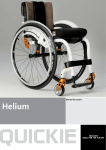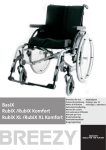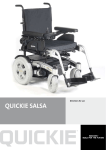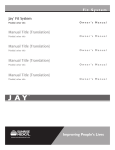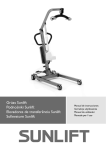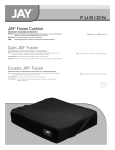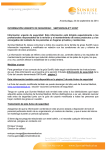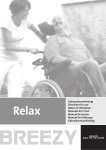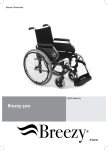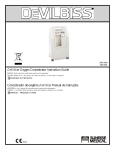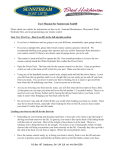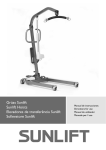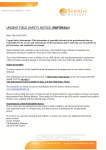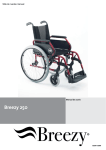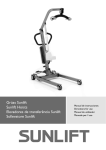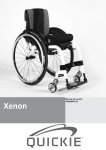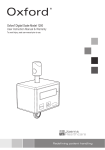Download brochure - Mobility Hire
Transcript
Sunlift Hoists Micro / 130 / 150 / 175 SUNLIFT Instructions for use 1. Introduction Thank you for choosing a Sunrise Medical product. You are advised to read this instruction manual and in particular the safety recommendations and adjustments to make before using the hoist. If you have any questions about usage, maintenance or safety, please consult an authorised distributor of our products. ENGLISH IMPORTANT: DO NOT USE THIS PRODUCT UNTIL YOU HAVE READ AND UNDERSTOOD THIS INSTRUCTION MANUAL Sunrise Medical has obtained certificate ISO 9001 which validates the quality of its products at all times. Sunrise Medical declares under its own responsibility that this product meets the requirements of Medical Directive 93/42/ EEC of Directive 2007/47/EEC. The Sunlift Hoists have the CE mark and meet the following CE directives: Medical Devices Directive (93/42/EEC) EMC Directive (89/336/EEC) (electrical components only) Low Voltage Directive (73/23/EEC) (electrical components only) The electrical equipment is approved in accordance with the standards: ETL (ul) Ul 60601, EN 6061, the Australian and Canadian deviation. EN- 60601-1 and UL 2601-1. Electrical specifications 12-volt batteries, rechargeable sealed lead-acid type. Battery capacity 2.9 amp-hours. Nominal input of charger 230 VCA 50/60 Hz Nominal output of charger 27.4/29.0 [email protected] Protection against electric shock Charger – class II Degree of protection IPX4 Elevator – internal power source Degree of protection against electric shock Charger – type B Lift – type B Use of sling/Oxford type/sunrise with grey loop Operational environment: ..............> +5° < +40° C. In conditions other than this environment, performance and safety may be compromised. 2. Recommended use The hoists are designed for moving and lifting patients. They must always be operated by a healthcare professional or a user instructed in their operation and safety. They are suitable for moving and lifting patients both in domestic settings and at hospitals or residential homes (depending on the specification of the model). Each lift is fully assembled, load tested and certified before being partially dismantled for packing. The packing consists of a strong, purpose built carton and is used for both export and domestic markets to ensure the safe arrival of the lift. A number of documents are supplied in a wallet packed with each lift and should be kept safely for future reference. • • TEST CERTIFICATE USER MANUAL The TEST CERTIFICATE is an important document and will be required for your insurance records. It is valid for six months and after it has expired the lift should be inspected and serviced for the next six months. Servicing and periodic testing can be carried out by your supplier*. Please ensure your lift is included in their maintenance schedule Note: These recommendations are in compliance with the requirements of 1998 No2307 Health and Safety: The Lifting Operations and Lifting Equipment Regulations 1998. This is a UK regulation. Outside the UK please check your local requirements *Sunrise Medical Ltd recommends maintenance, inspection and certified testing is carried out by authorised service dealers only 2 ENGLISH The Sunlift Hoist range is suitable for the following CATEGORIES of lift within the working parameters of the lifts specified in the TECHNICAL SPECIFICATIONS. . Category A - Wheelchair . Category B - Bed . Category C - Bath . Category D - Toilet/Shower Chair . Category E - Floor . Category F - 90 degree Rotation The Sunlift Hoist is suitable for patients in the SITTING, SITTING/RECUMBENT and RECUMBENT position 3. Safety instructions • Always familiarise yourself with the controls and safety devices on your hoist before using it to lift a patient. • Use only slings recommended for use with this hoist. • Never force any control or safety device. All controls are easy to use and do not require any great physical force. • Do not use hoists in showers. • Do not charge hoists in bathrooms. • Do not use these hoists for any purpose other than lifting and moving patients. • For your safety please pay special attention to the yellow triangular warning labels indicating the areas where there is a danger of finger entrapment. • Use the hoist only as per the instructions in this manual. Before and during each use of the hoist: • Use the hoist only on flat, smooth surfaces. • Please be aware that the physical forces required to move the hoist when laden on carpeted or uneven and rough textured surfaces will be greater than those required on a flat or smooth surface. Careful planning of the lifting operation is recommended in these environments to avoid potential damage to the hoist due to heavy handling • Always check before use that the sling is of a type and size suitable for the patient. • Do not use the lift until you have check that the actuator is secured at both ends by a bolt and nut. • Check the parallelism of the legs of the hoist. If the legs are toed inwards, see Fig.1 (by more than 3 degrees) and not parallel, (the legs closed position(F) as described in Technical Specifications section) and dimension F is reduced by more than 100 mm DO NOT use the hoist in this position. • Always check that the safe working load of the hoist is sufficient for the weight of the patient. • Adjust sling as per the relevant instructions for use. • Do not lift the patient until you have ensured that the patient’s hands are kept within the harness, making sure the patient does not hold on to the actuator or the hoist’s mobile joints. • When lifting or lowering the patient, the attendant and hoist operator must keep his or her hands away from the actuator and the connecting and turning parts between the arm and the mast. • Before moving a patient ensure that they are comfortable and as close as possible to the floor. • Move the hoist with care: there is a risk of crushing the feet between the base of the hoist and the floor. • To push the hoist along use the push handle on the mast, and never the mast itself, the boom or the patient. • When transporting a patient never move the hoist at more than 3 kph or 0.8 metres per second. • Do not try to push the hoist over any obstacle which its front castors cannot easily overcome. • Do not use the hoist on inclines of more than approx. 5º. SUNRISE MEDICAL recommends that the aid of a third person be enlisted when moving patients on slopes. • Never leave the hoist with a patient unattended on a slope. 3 4. Characteristics Boom ENGLISH Push handle Mast Batteries Control box Leg adjuasting lever . Rear braked castor 5. Assembly Open the box carefully in a large open space. The box contains: • Main chassis with 4 castors • Mast assembly with boom and spreader bar, and charger base • Electric actuator • Hand control • Batteries • Charger cable 1. Remove all parts from the box and lay them out on the floor. Some parts are heavy and may require two people to lift them. 2. Engage the brakes on the rear castors of the chassis. 3. Insert the mast into the rectangular plinth in the chassis as far as the red arrow on its side. Then turn the handle clockwise to ensure that it is firmly secured. WARNING: keep your fingers away from the end of the mast when inserting it into the chassis. Mast Leg adjusting lever 4 Mast locking knob 4. Check that the legs open and close normally. 5. Assembly of the actuator: Elevate the lift boom and place the actuator so that the holes in the mast plates are aligned with the actuator base. Insert the bolt through and hole and tighten the nut 6. Connect the batteries box into the base by sliding it along the rail of the mast. To remove the battery box, pull it upwards by the handle and then push it towards the outside. 7. Check that the red emergency stop button on the charger base is not pressed. ENGLISH 8. Insert the plug of the hand control into its receiving socket under the charger base. 9. Plug the actuator into its socket under the charger base. For a correct positioning firmly press the pin up until completely inserted in place. 10. Push the hand control buttons up and down and check that the boom moves up and down properly. The hoist is now ready for use. 6. Use 1. Leg adjustment: The legs of the hoist can be moved apart or closer together to facilitate access to a wheelchair, toilet, etc. When going through narrow doorways or passageways the legs should be fully closed. Adjust them by pressing downwards on the foot pedal. (Operation force <300N) Right pedal = legs fully closed Left pedal = legs fully open 2. Rear castors and braking: The hoist has two rear braked castors. The rear castors must be left free when the boom is raised so that the hoist can move towards the centre of gravity of the hoisting line. If the brakes are engaged it will be the patient who moves towards the centre of gravity, which may cause discomfort. 3. Raising and lowering the boom: Boom movement is via an electric actuator controlled by a simple hand control unit. This unit has two buttons marked with arrows UP and . The actuator stops automatically at the end of its travel in both directions. The hand control unit is connected to a socket under the battery box charger base. 4. Emergency stop button: The red emergency stop button in the frontal of the battery charger base cuts all power to the hoist. Power cannot be restored until the button is turned in the sense of the arrows. It will be reset by twisting the button clockwise and releasing. 5. Emergency down: This allows you to automatically lower the hoist’s mast, if the hand control should fail. This last manoeuvre can be done both manually and electronically. • Manually (only Sunlift 130, 150 , 175 models): by twisting the cylinder at the top of the actuator clock-wise, the engine is released mechanically, allowing safe descent of the user. • Manually (only Micro model): it is red, and is located at the bottom of the actuator. Pull it upwards, in the direction indicated by the PULL EMERGENCY arrow • Electronically (only Sunlift 130, 150 , 175 models): the button is located under the battery charger base. It is a switch that requires operation with a fine point (such as a pen, for instance), and can be found under the word EMERGENCY, with an arrow pointing down. Batteries Emergency stop button Hand control Emergency down button Actuator motor Charging socket 5 6. Use (Continued) 6. Mobilising the hoist and patient transfer: Mobilising the hoist must always be performed with the caregiver firmly holding both push handles. Transfer of the patient should be performed with the patient slung in front of the caregiver 7. Battery charging ENGLISH Charging the battery Batteries are fitted in a battery case which fits into the charger base on the mast. Charge the batteries with the charger cable provided. An additional charger base and battery are available as accessories, enabling one to be recharging at all times. 1. Connect the charger cable to the charging socket on the charger base. 2. Connect the cable to the mains (220V/ 240 V). 3. Recharging is automatic. A full battery charge lasts between 8 and 12 hours. 4. To use the hoist, first disconnect the charger cable from the mains, and then from the hoist. 5. The lights indicate the charge of the batteries: • “ON” green light c Connected to the mains • “CHARGE” orange light c Batteries are charging • “CHARGE” light will turn off once batteries reach full charge Before battery is completely discharged, every time you push the lift/descend button in the hand control, a beep will warn you that you can perform one last action using the Emergency down button. 6. The batteries are protected from fully discharging by a charge level alarm. If the hoist is not in use, the warning beep will not sound. DO NOT IGNORE THIS WARNING SIGNAL. Finish the operation you are carrying out when it goes off and then connect the hoist for recharging. 7. The recharging is done automatically. Note: Even if the charger is left connected for a long time, it will not allow the batteries to overcharge. 8. In order to operate the hoist again, please disconnect the charger cable Batteries Charging socket 8. Battery maintenance • Keep batteries fully charged. When the hoist is not in use, keep it charging. Batteries may also be recharged overnight if this is more practical: the charger will not allow the batteries to be overcharged. • Charge batteries regularly even if the hoist is not used for a long period. • Connect the charger cable first to the hoist and then to the mains. • Do not leave the charger cable plugged into the hoist if it is not to be connected immediately to the mains. • Never unplug the charger cable by pulling on the cable. 6 9. User guide for the quickfit sling From a sitting position Fig. 1 Fig. 2 Fig. 3 ENGLISH Fig. 1 Ensure that the straps face outward. Pull the sling down over the user’s back until the top of the toilet seat opening is at the small of the back. Check that the sling is aligned properly at shoulder height. Fig. 2 Lift the patient’s leg and slip the strap under it and pull it up between their legs, ensuring that the sling is not creased under the thigh. Repeat the procedure with the other leg. Fig. 3 Cross the straps over the legs and attach them to the front hooks on the hoist spreader bar. Fig. 4 Raise the hoist slightly and attach the shorter, shoulder straps to the spreader bar. Move the hoist towards the patient while doing this. Fig. 4 REMEMBER: THE LONG STRAPS ARE FOR THE LEGS, AND THE SHORT ONES FOR THE SHOULDERS. From a lying position Fig. 5 Roll the patient over onto the sling, ensuring that the top of the toilet seat opening is at the small of the back. Fig. 6 Cross the straps under the patient’s legs and fit the sling as indicated for the sitting position, keeping the shoulder straps as short as possible. Fig. 5 Fig. 6 NB: ENSURE THAT THE PATIENT’S HEAD IS SUPPORTED AT ALL TIMES 7 ENGLISH 10. Problems and solutions PROBLEM CAUSE SOLUTION Actuator does not work Emergency button pressed Total battery discharge protection activated Poor connection of the control plug Turn it in the sense of the arrows Charge the batteries Reinsert the control plug Batteries do not charge Fully charged battery (green light) Verify power source The actuator stops Overload in the hoist Reduce the load on the actuator Batteries discharged (sound warning when pressing Charge batteries the hand control: protection against total discharge activated) Fig. 4 11. Maintenance Sunrise Medical Ltd recommend a thorough inspection and test of the Sunlift hoist and lifting accessories, slings etc. is carried out every six months. Sunrise Medical Ltd recommends maintenance, inspection and certified testing is carried out by authorised service dealers only. Note: These recommendations are in compliance with the requirements of 1998 No2307 Health and Safety: The Lifting Operations and Lifting Equipment Regulations 1998. This is a UK regulation. Outside the UK please check your local requirements All SUNRISE MEDICAL products are designed for minimal maintenance, but some regular safety checks are necessary. SUNRISE MEDICAL recommends that the following checks be made every day, before the hoist is used. • Ensure that the front castors of the hoist move normally. • Ensure that the spreader bar rotated and rocks freely. • Check that the spreader bar is securely attached to the boom. • Ensure that the legs of the hoist open and close normally. • Ensure that the hand control unit is being used properly. • Check that the emergency stop button works properly. • Check for wear on the hooks. Do not use slings which show signs of wear or damage in the lifting straps or sling body. SUNRISE MEDICAL also recommends that the following parts of hoists be serviced by an authorised technician at least once a year: • SPREADER BAR - Check that the spreader bar rotates and rocks freely - Check that the spreader bar is securely attached to the hoist boom • BOOM - Check the coupling between boom and mast - Check that the boom rotates fully on its bearing • MAST - Check that the mast is properly fitted into its plinth - Check the hydraulic actuator assembly • BATTERY CASE - Check that the emergency stop button works properly 8 ENGLISH - Check the plug of the hand control unit and actuator • LEG ADJUSTMENT - Check legs open and close smoothly and that these are parallel (+/-3º) - see Fig1 • LEG PIVOTS - Check that these are firmly secured - Check that the legs pivot freely - If they are stiff, lubricate them with mineral oil - Check for excessive play • FRONT CASTORS - Check that these are firmly secured to the legs - Check that castors and their supports rotate freely - Clean away any threads, hairs or fluff which might have built up. - Lubricate with mineral oil if necessary • ELECTRIC ACTUATOR - Check that this works properly and without any abnormal noises • BATTERIES - Recharge regularly - Do not allow them to become completely discharged • CHARGE TEST - The charge test should be performed by an authorised service technician • CLEANING - Clean with ordinary soap and water or a disinfectant for hard surfaces - Do not use aggressive or abrasive cleaners, as the surface finish might be damaged - Do not allow water to come into contact with electrical components AVAILABLE SPARE PARTS: When ordering spare parts it is important to indicate the hoist’s series number to ensure that you receive the right spare part for your hoist. The available spare parts are: • Harnesses • Batteries • Joystick • Control box • Actuator • Wheels • Complete hanger • Complete chassis • Complete arm and mast • Charger or charging lead 9 12. Technical specifications ENGLISH Measurements 130 kg 130 kg 150 kg 150 Midi Major 175 Max total length 1010 mm 1120 mm 1215 mm 1340 mm Min total length 970 mm 1090 mm 1155 mm 1265 mm Safe working load (w ith w heels facing outw ards) (w ith w heels facing inw ards) Micro Mini 130 175 kg Max width with legs closed 575 mm 575 mm 665 mm 665 mm Max height (without load) A 1835 mm 1865 mm 1930 mm 1985 mm Min height (without load) (B) 1085 mm 1255 mm 1255 mm 1425 mm Max spreader bar heigt (without load) (C) 1590 mm 1610 mm 1680 mm 1755 mm 350 mm 460 mm 450 mm 550 mm 1130 mm 1240 mm 1380 mm 1500 mm Max width (external) 965mm 1055 mm 1205 mm 1220 mm Max width (internal) 885 mm 980 mm 1120 mm 1140 mm Max width (external) 535 mm 535 mm 625 mm 625 mm Max width (internal) 455 mm 455 mm 545 mm 545 mm Total leg height 100 mm 100 mm 100 mm 115 mm Ground clearance 20 mm 20 mm 20 mm 15 mm Castor wheels 75 mm 75 mm 75 mm 75 mm Rear wheels 100 mm 100 mm 100 mm 100 mm Mast, boom and electric components assembly weight Base assembly weight 18,65 kg 19 kg 19,3 kg 22,65 kg 13,5 kg 14 kg 15,1 kg 18,1 kg Min spreader bar height (without load) Turning radius with legs open (D) Legs open (E): Legs closed (F): Batteries weight Batteries Batteries capacity Charger input Chager output Electric shock protection Degree of shock protection 10 2,9 kg 2,9 kg 2,9 kg 2,9 kg 2x12v de gel ácido 2x12v de gel ácido 2x12v de gel ácido 2x12v de gel ácido 2.9 Amph 2.9 Amph 2.9 Amph 2.9 Amph 230v / 50 Hz 0.12 A 230v / 50 Hz 0.12 A 230v / 50 Hz 0.12 A 230v / 50 Hz 0.12 A 28v. 0.5 Amph 28v. 0.5 Amph 28v. 0.5 Amph 28v. 0.5 Amph Charger: Clase II Hoist: Internal power source Charger: Clase II Hoist: Internal power source Charger: Clase II Hoist: Internal power source Charger: Clase II Hoist: Internal power source Charger and hoist: Type B Charger and hoist: Type B Charger and hoist: Type B Charger and hoist: Type B PRODUCT DURABILITY • The minimum service life of the Sunlift hoists is five years, which can be extended significantly with appropriate maintenance. • The service life of the batteries is of one to two years depending on usage and the number of times they are recharged. • The service life of the harnesses is of one to two years depending on usage and the number of times they are washed, as well as the detergents used and type of water. ENGLISH 13. Warranty SUNRISE MEDICAL guarantees this product for two years as from the date indicated on the invoice, receipt or delivery note. For products containing batteries, the battery warranty is 6 months. This warranty covers parts in need of replacement, labour and transport. In warranty claims the user must submit the product and the purchase invoice as proof of delivery date. This warranty does not cover: • NORMAL WEAR AND TEAR, e.g. on upholstery, tyres, inner tubes, rims, wheels, fabric, etc. • ACCIDENTS, e.g. bent structures, scratches, flat tyres, etc. • IMPROPER USE and damage caused by users who weigh more than the weight limit indicated in the user’s manual. • LACK OF MAINTENANCE and failure to follow the conservation instructions in the user’s manual. • MODIFICATIONS or REPAIRS carried out by persons not authorised by Sunrise Medical. • PRODUCTS WITH NO INVOICE OR SERIAL NUMBER (when appropriate). 14. Disposal The symbols below mean that in accordance with local laws and regulations your product should be disposed of separately from household waste. When this product reaches the end of its service life, take it to the collection point designated by local authorities. Separate collection and recycling of your product at the time of disposal will help conserve natural resources and ensure that it is recycled in a manner that protects the environment. Ensure you are the legal owner of the product prior to arranging for its disposal in accordance with the above recommendations. 11 Sunrise Medical GmbH & Co.KG Kahlbachring 2-4 69254 Malsch/Heidelberg Germany Tel.: +49 (0) 7253/980-0 Fax: +49 (0) 7253/980-111 www.sunrisemedical.com Sunrise Medical Limited High Street Wollaston West Midlands DY8 4PS England Tel.: +44 (0) 1384446688 www.sunrisemedical.com Sunrise Medical S.L. Polígono Bakiola, 41 48498 Arrankudiaga – Vizcaya España Tel.: +34 (0) 902142434 Fax: +34 (0) 946481575 www.sunrisemedical.com Sunrise Medical S.A. 13, Rue de la Painguetterie 37390 Chanceaux sur Choisille France Tel.: +33 (0) 247554400 Fax: +33 (0) 247554403 www.sunrisemedical.com Sunrise Medical Srl Via Riva 20, Montale 29100 Piacenza (PC) Italy Tel.: +39 0523-573111 Fax: +39 0523-570060 www.sunrisemedical.com Sunrise Medical A.G. Lückhalde 14 3074 Muri bei Bern Switzerland Tel.: +41 (0) 31-958-3838 Fax: +41 (0) 31-958-3848 www.sunrisemedical.com Sunrise Medical AS Rehabsenteret 1450 Nesoddtangen Norway Tel.: +47 (0) 66963800 Faks: +47 (0) 66963838 www.sunrisemedical.com Sunrise Medical AB Britta Sahlgrens gata 8A 421 31 Västra Frölunda Sweden Tel: +46 (0) 31-748 37 00 Fax: +46 (0) 31-748 37 37 www.sunrisemedical.com Sunrise Medical B.V. Groningenhaven 18-20 3433 PE Nieuwegein Nederlands Tel.: +31 (0) 3060-82100 Fax: +31 (0) 3060-55880 www.sunrisemedical.com G2 A/S Graham Bells Vej 21-23 A 8200 Arhus N Denmark Tel.: +45 87 41 31 00 Fax: +45 87 41 31 31 www.G2.dk OM Sunlift Hoist 25.07.14 Pantone (Spot Colors): Cool Gray 10 Cool Gray 6 Ref. P19107













